




By Ebony JJ Curry SENIOR REPORTER
By Ebony JJ Curry SENIOR REPORTER
Late Thursday night, Sept. 14, a historic moment unfolded in American labor relations as the United Auto Workers (UAW) union initiated a strike against Ford, General Motors (GM), and Stellantis. For the first time, the union took simultaneous action against all three major Detroit-based automakers. The action involves approximately 13,000 UAW members in assembly plants across Michigan, Ohio, and Missouri, who walked off their jobs after existing labor contracts expired at 11:59 p.m.
By Ebony JJ Curry SENIOR REPORTER
IUnder harsh fluorescent lights and a courtroom heavy with silence, John Antonio Poole stood at 18 years old as a judge pronounced life without parole. His face was barely past adolescence, yet the system saw him only as an adult deserving of permanent punishment. That moment became a defining stamp on a life many believed was beyond repair. Poole’s case, rooted in a 2002 act of violence for which he was paid $300 by his uncle to carry out a fatal shooting, ultimately became the catalyst for the Michigan Supreme Court to examine the legal gap that excluded 18-year-olds from protections previously granted to minors. Now 42 years old and incarcerated at Richard A. Handlon Correctional Facility, Poole is no longer just a case number—he is the reason a pathway to reconsider justice for hundreds has been opened.
Shortly before midnight on Sept. 14, GM released a statement expressing disappointment with the strike action, despite offering what it termed an “unprecedented economic package” that included historic wage increases. Stellantis
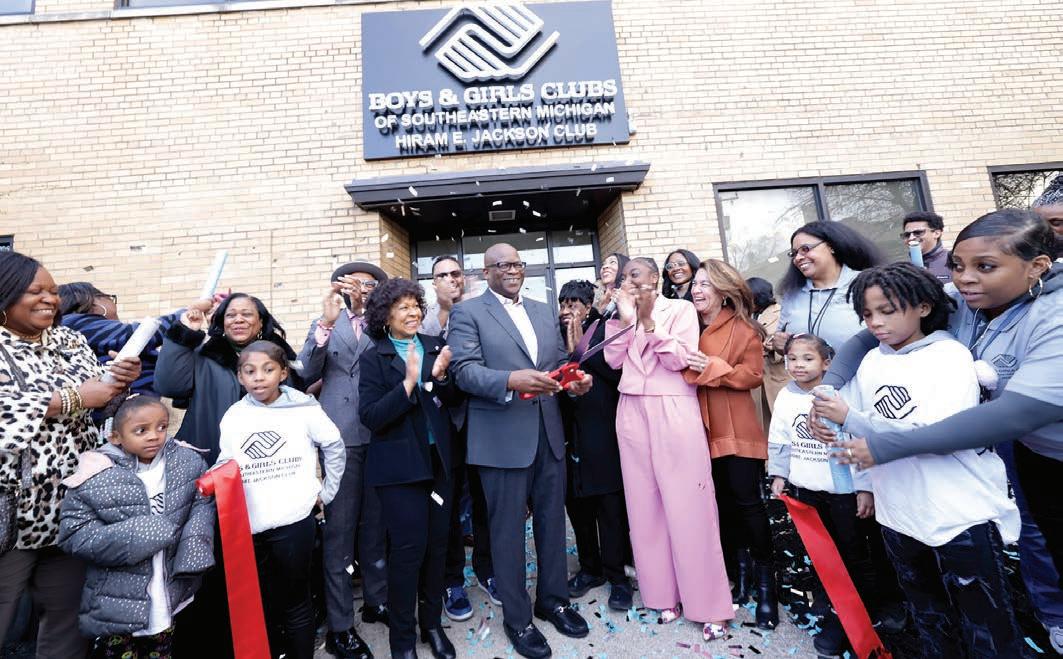
their city is a powerful testament to the resilience and ingenuity of our community.
Poole’s attorney, Maya Menlo, said in a statement: “Eighteen-year-olds are less culpable and more amenable to rehabilitation than adults whose brains are fully developed. Mr. Poole and others like him deserve an opportunity to return to the community.”
n a breathtaking celebration of talent, determination, and the unyielding spirit of Black excellence, the Michigan Chronicle marked its 10th Annual 40 Under 40 event Thursday evening. This year’s soirée, drenched in the theme “All Black Everything with Gold Accents,” transcended expectations and essentially illuminated the golden gems within the true essence of Black excellence. Hosted by the charismatic duo of Andre Ash and Lynzee Mychael from Michigan Chronicle’s Finally Friday, the night was a triumph for the city of Detroit and its vibrant community of young Black pro-
As the night unfolded, we had the privilege of honoring other outstanding individuals, each carving their own path to success. Clement “Fame” Brown, the creative mind behind Three Thirteen Detroit’s Brand Name, received the prestigious Entrepreneur of the Year Award. Brown’s commitment to empowering the city through fashion and entrepreneurship has left an indelible mark.

By Jeremy Allen EXECUTIVE EDITOR
The evening sparkled with a golden promise as we celebrated remarkable individuals from various walks of life. Among the honorees were the brilliant and visionary co-founders of Detroit Hives, Nicole Lindsey and Timothy Paul Jackson. Their work has not only changed the landscape of beekeeping and urban farming in Detroit but also exemplified the transformative impact Black professionals can have on their communities.
By Ebony JJ Curry SENIOR REPORTER
As a teenager attending Detroit Country Day School, Hiram E. Jackson once got into a fight after another student disparagingly said to him: “You can take them out of Highland Park, but you can’t take the Highland Park out of them.”
“Entrepreneur of the year – that’s a big deal,” said Brown. “It’s always an honor to be honored and it’s always a blessing to be in a room full of so many talented, accomplished, and popular people that look like me. I’m geeked. I started making and selling clothes as a kid and I always knew that I would have a business, but I never knew it would be Detroit’s brand name business, so I take a lot of pride in the fact that our business represents our city’s pride.”
Taking home the Corporate Excellence Award was Dannis Mitchell, Director of Community Engagement at Barton Malow.
cy mode to protect its operations.
“Together we have created a social, environmental, and financial impact through bees,” said Jackson. Lindsey followed that sentiment with, “It is through our local partnerships and collaborative efforts that we exist in over 28 plus locations managing the health of 4.5 million honeybees – humbly speaking our movement has inspired others locally, nationally, and even internationally to take on similar missions.”
Thanks to a unanimous decision from the Michigan Supreme Court, Poole’s case and the cases of more than 250 individuals, all sentenced to life without parole for crimes committed at age 18, will be granted a second look. Not a guarantee of release, but a requirement that their cases be reviewed to determine if they’ve changed, matured, and are capable of returning to the communities that once turned their backs on them.
For many Detroiters, Interstate 375, or I-375, has long been just another stretch of urban highway, a concrete artery connecting different parts of the city. To some, it’s a mere convenience; to others, it’s an unremarkable part of their daily commute. However, there’s a deeper, far more troubling story beneath the surface of this seemingly ordinary freeway—a story of pain, displacement, and the lasting impact on Black Detroiters.
received the honor of a lifetime, as his childhood Boys & Girls Club – where he became a member in 1971 at the age of 6 – was renamed in his honor following a $2 million renovation. With the dedication, the Hiram E. Jackson Club is the first of all the Boys & Girls Clubs of Southeastern Michigan to be named after an African American.
DPD Chief James White Says Increased Police Presence Culled Violence By Andre Ash
ness district that had been the lifeblood of the community.
dedication to the club led him to a seat on the BGCSM board, and ultimately, he became the first Black chairman of the BGCSM board, where he served for more than five years and helped select the organization’s current president and CEO.
The UAW has branded the industrial action as the “Stand-Up Strike,” focusing on specific plants within each automaker. UAW President Shawn Fain stated, “This strategy will keep the companies guessing. It will give our national negotiators maximum leverage and flexibility in bargaining. And if we need to go all out, we will. Everything is on the table.” Union leaders have also indicated that additional plants could be targeted in future waves if negotiations remain stalled.
But on Monday, April 7, 2025 –standing in front of hundreds of friends, family members, mentors, colleagues, elected officials, and other dignitaries at the Boys & Girls Club of Highland Park–Jackson said that hearing that exact phrase today would be a compliment of epic proportions.
Detroit Hives, a pioneering organization founded by Lindsey and Jackson, harnesses the power of urban beekeeping to revitalize neighborhoods in the Motor City. Their initiative not only addresses critical issues like environmental conservation but also provides valuable education and employment opportunities to Black De
This ruling expands on previous court decisions that had only extended such consideration to those under 18. The court made clear that 18-year-olds—only one year removed from childhood in legal terms— deserve the same chance. They must now be given the opportunity to prove whether their time behind bars has brought about rehabilitation.
By Andre Ash DIGITAL ANCHOR
The CEO of Real Times Media and Publisher of the Michigan Chronicle
“It is so important to recognize that there are young leaders across the country, many that are born here in Detroit. I represent our city nationally and I tell people, ‘Yea I’m a D-girl I’m from the west-side of Detroit,’” Mitchell expressed. “But more importantly, I’ve been able to have experiences within an industry that not many of us, specifically women of color, have the opportunity to engage in and I’ve been the youngest person in the room, the only Black person in the room, and the only Sistah in the room, and I really had to articulate the importance of showing up, giving chances when others won’t, and being persistent.” As a trailblazing Black woman thriving in a predominantly male-dominated industry, her
It’s a history marred by pain, injustice, and economic devastation. More than 130,000 residents, primarily Black, were forcibly displaced. Families were uprooted, generational wealth was obliterated, and a thriving community was torn asunder. The wounds inflicted by I-375 run deep, transcending the physical barrier of a freeway to penetrate the very soul of Black Detroiters.
For the past five decades, Jackson has been an “all-in” member of the club.
This painful legacy can be traced back to the nation’s interstate highway program
As a child, he attended daily. The Boys & Girls Club of Highland Park was his first job, where he started working as a coat checker in the very room where he spoke during the club’s renaming on Monday. He returned frequently as a young adult, volunteering his time and money to support programming and community initiatives. Later, Jackson’s
That opportunity comes in the form of resentencing hearings. Each person affected will now have the chance to stand before a judge and show whether they’ve taken responsibility, grown past the violent choices of youth, and demonstrated potential to rejoin society with purpose.
The tale begins in what is now Lafayette Park, once known as Black Bottom—a neighborhood rooted in African-American culture and history. Named after its dark, fertile soil, Black Bottom flourished during the mid1900s, nurturing the dreams and aspirations of prominent Detroiters like Coleman Young, Joe Louis, and numerous other Detroit legends. But in the name of urban renewal in the 1950s, this vibrant neighborhood was systematically dismantled, erased from the map, and replaced by a lifeless stretch of asphalt.
A string of shootings in Greektown in mid-April left both visitors and residents of this bustling downtown destination in awe. One of these shootings tragically claimed the life of a popular and beloved security guard following a dispute with a patron. The male suspect allegedly shot the guard before fleeing the scene, while his female companion is accused of concealing the weapon in her bra.
towards mending the wounds inflicted on Black Detroiters and restoring a sense of belonging that was so callously torn away in the past.
The I-375 Boulevard Project is about more than just correcting historical injustices; it’s about redefining the future. It will connect downtown Detroit to surrounding neighborhoods, bridging the gap that was placed upon the city decades ago.
Fain clarified the union’s strategy: “I want to give a major shoutout to the thousands of members who are on the picket lines right now fighting for all of us. The Stand-Up Strike is a new approach to striking. Instead of striking all plants at once, select locals will be called on to stand up and walk out on strike. This is our generation’s answer to the movement that built our union – the sit-down strikes of 1937. We told the Big 3 that Sept. 14 was the deadline and we meant it. We gave the companies our economic demands eight weeks ago and it took more than a month to get to the table.”
“Everything that I’ve ever done and everything that I’ve hoped to do is rooted in the time I spent as a youth at the Boys and Girls Club. It’s something that is very much a part of my DNA. I’ve witnessed the impact that it can have on children, on families, and on communities. That’s why I’m so committed to it. It’s really how I got to Detroit Country Day and how I got to Cornell,” Jackson said. “It’s kind of like when you build a house, you build a basement first as your foundation. The Boys & Girls Club is very much my foundation, and the things that have come after that have been successful because I just have an amazing foundation from not just my wonderful parents, but from being a Club kid.”
This shift challenges a long-standing legal boundary that drew a hard line at the age of 18. That line ignored growing research showing that brain development, especially in the areas responsible for impulse control,
The union is pushing for a comprehensive list of demands. This
Homelessness continues to plague urban communities, with families and individuals grappling with the challenges of making ends meet in today’s economic climate. Whether it’s struggling to meet monthly mortgage payments or coping with soaring rental costs in a housing market marked by shockingly high prices, a variety of factors contribute to the growing issue of people becoming unhoused.
While the residential areas bore the brunt of this demolition, the heart of Black Bottom, its thriving business center, remained largely untouched. Restaurants, theaters, clubs, and bars—the very places that brought Detroit’s Black community together—were concentrated around Hastings Street, the epicenter of African-American culture in the city.
Then, in a cruel twist of fate, Hastings Street, too, was obliterated a few years later, making way for the construction of I-375. This marked the final blow, sealing the fate of Black Bottom and signaling the beginning of the end for Paradise Valley, the Black busi-
DunnJulie Schneider

Historically, shelters have provided a temporary respite for those in need, often serving as the first or second option after exhausting alternatives like staying with friends or family. Shelters offer a place to rest one’s head and a warm meal, albeit sometimes for extended periods. For others, being unhoused means living in cars or makeshift outdoor
nity Action Agency manages the helpline, making it accessible to all Detroit residents. This initiative simplifies access to the City’s various housing services, ensuring that residents in need can easily find assistance.
These incidents unfolded during an unseasonably warm spring, leading to increased pedestrian traffic and heightened tensions in the densely populated downtown

By Amber Ogden STAFF WRITER
By Lynzee Mychael
The causes of homelessness are as diverse and complex as the individuals experiencing it. In response, the City of Detroit has adopted a holistic approach to combat this issue.
the
JOURNALIST
the
“Providing services and high-quality housing to persons at risk of or who are experiencing homelessness is a key priority of the City of Detroit, said Julie Schneider, Director of Detroit’s Housing and Revitalization Department.
What a Federal Government Shutdown Could Mean for Detroiters?
“This means focusing on building the pipeline of supportive housing and coordinating with the Continuum of Care on the delivery of critical resources such as emergency shelter, rapid rehousing, and diversion and prevention programs. It also means preserving and expanding affordable housing options for Detroiters of all incomes and improving housing stability though comprehensive service offerings available through the Detroit Housing Resource HelpLine and Detroit Housing Services Division within HRD.”

Detroit’s long-standing struggle with food insecurity is set to deepen as new tariffs drive up the cost of imported goods this week, making fresh and affordable groceries even harder to access. Already labeled a “food desert” due to its limited grocery options, the city’s most vulnerable residents now face rising prices that could push healthy food further out of reach. With economic pressures mounting, the question remains: can Detroit overcome its food access crisis, or will these tariffs make survival even tougher?
In May 2023, the City of Detroit launched the Detroit
Today, the resurgence of Paradise Valley stands as a testament to the indomitable spirit of Black Detroiters and the enduring legacy of Black excellence. This historic district, once a vibrant hub for Black businesses and culture, is experiencing a renaissance that harkens back to its glory days. The destruction of Black Bottom may have torn apart a thriving community, but the resolute determination of a new generation of entrepreneurs and visionaries is reclaiming that lost legacy.
He explained that one of the first people he met while at the club was the late George Browne. Browne, a camp counselor, helped provide opportunities to the boys, and he was the catalyst for encouraging Jackson to develop a relationship with a young Courtney B. Vance. Vance, an Emmy nominee and Tony Award winner, is a native Detroiter who was also a member of the Highland Park Boys & Girls Club in the late 1960s and the early 1970s.
The surge in crime and the influx of visitors to Detroit’s downtown core garnered the attention of the Detroit Police Department (DPD), catching them somewhat
James White, Chief of Police for the Detroit Police Department, said: “We were caught somewhat flat-footed right out the gate. By design we went into the spring deployment, which is less than the mid-summer deployment, and saw we say an uptick in violence that first warm weekend.”
and other partners, this ambitious project aims to create jobs, remove barriers to economic growth, and reconnect the neighborhood with the rest of Detroit. It is a step
troit is changing. While major grocery chains have largely abandoned the city over the years, independent markets, urban farms, and community-led initiatives have attempted to fill the void.
“The city and its partners offer a lot of great services to help Detroiters with their housing needs, but they don’t mean much if people don’t know how to access them,” said Mayor Mike Duggan. “Thanks to the efforts of our partners and the generous support of the Gilbert Family Foundation, we now have a simple process to guide residents to the right housing resource and a growing number of programs to help them.”
The Gilbert Family Foundation’s broader commitment involves pledging $500 million to support projects across Detroit over the next ten years, with housing initiatives being a significant part of their contribution.
Notably, Detroit has witnessed a consistent decrease in recent years, with the number of unhoused residents steadi ly declining. In 2019, approximately 7,847 people were unhoused and entered the City’s community response system. In 2021, about 5,687 people experienced homelessness.
The USDA defines food deserts as low-income communities where a significant portion of the population lives more than a mile from a supermarket in urban areas (or more than 10 miles in rural areas).
In the heart of Paradise Valley, Blackowned businesses are not just flourishing but thriving, offering diverse services, products, and experiences that pay homage to the past while paving the way for a prosperous future. From jazz clubs to soul food restaurants, the Black Press, and art galleries to fashion boutiques, this revival is breathing life into the very essence of what once made this neighborhood a vibrant cultural epicenter. It’s a resurgence that extends beyond brick and mortar; it represents the resurgence of a spirit that refuses to be subdued.
Vance, now a Boys & Girls Club of America Hall of Fame member, became a mentor to Jackson, as he also matriculated through the club before attending Country Day and going on to graduate from an Ivy League college, just like
Chief White attributes the violence in Greektown to a combination of weather conditions and a surge in pop-
He explained, “ We saw numbers downtown that we have not seen, ever. People are emerging from COVID and there’s a feeling that we’re in a post-COVID era… and with the venues downtown and the reasons to come down with all the activities that are going on, we saw hundreds of more people and, in particularly, young folks, teenagers that we hadn’t seen.”
Detroit City Councilman Fred Durhal III, representing District 7, where Eastern Market resides, told the Michigan Chronicle, “It’s still very early in the process, MDOT is

According to the City of Detroit, since the start of the fiscal year 2019 to 2021, Detroit saw a 28% decrease in the
Detroiters are reclaiming their place in the city, despite the challenges posed by gentrification.
According to a 2017 report from the Detroit Food Policy Council, nearly 30% of the city’s residents lacked easy access to grocery stores. Yet, the food landscape in De-
During the Great Migration, thousands of Black families from the South came to Detroit in search of jobs in the booming automobile industry. Despite facing discrimination and segregation, they built vibrant communities on the
For decades, Detroit had a glaring lack of major supermarket chains. By 2007, national grocers such as Kroger and Meijer had a mass exodus from the city, with the exception of two Meijer locations in the city limits, citing crime, high insurance costs, and operational challenges. This left residents to rely on smaller stores, many of which had limited fresh produce and higher prices. A 2014 study by the Fair Food Network found that only 8% of Detroit’s food retailers were full-service grocery stores, while more than 1,000 convenience stores and liquor stores dominated the landscape. However, recent investments have changed the landscape. Meijer reentered Detroit in 2013, opening two locations, followed by Whole Foods in Midtown. More recently, chains such as Aldi and Fresh Thyme have expanded their pres-
ence, improving access to fresh food. While these developments have helped, residents could argue that large swaths of the city remain underserved and are still paying un-
White explains. It has been a
for some, and some have tested it. If you are legally carrying a weapon and carrying a CPL, have a great day. If you’re
By Ebony JJ Curry SENIOR REPORTER
No parent plans to raise a child who ends up navigating the cold floors of a shelter instead of the warmth of a family home. No child dreams of growing into an adult who cycles through the system, one inpatient treatment center after another, looking for a place to lay their head once the detox wears off. Yet this is the reality many Detroiters face when the high wears off, and the trauma remains.
Detroit has taken a significant step toward expanding its network of recovery housing for individuals battling substance use disorders. With funding secured through national opioid settlement agreements, the city is allocating over $2 million across a set of long-term contracts aimed at not only treating addiction but sustaining recovery through stable housing.
Self Help Addiction Rehabilitation (SHAR) and Second Chance 2000 were formally selected by the Detroit City Council on Tuesday, April 2, with SHAR receiving a $1.2 million contract and Second Chance awarded $806,436. The contracts span three years and are part of a broader push to ensure residents in recovery can find structured, safe environments once they’ve completed inpatient care. The initiative is more than numbers—it’s about disrupting the pipeline that leads people from treatment back to trauma, from hospital discharge to homelessness.
In 2023, Detroit accounted for 430 opioid-related deaths, representing over 15% of Michigan’s total overdose fatalities. This figure underscores the city’s struggle with opioid misuse and its devastating impact on the community. Moreover, the Detroit Fire Department reported administering naloxone—a life-saving overdose reversal drug—2,400 times that year, highlighting the frequency and severity of overdose incidents within the city.
Statewide, Michigan has witnessed alarming racial disparities in overdose deaths. In 2022, Black residents comprised 28% of the state’s 2,998 overdose fatalities. Preliminary data from the first half of 2023 indicates that Black Michiganders were overdosing at a rate 2.7 times higher than their white counterparts. This disproportionate impact is particularly evident in Detroit, where Black residents accounted for almost half of all overdose deaths in the state. Over the past five years, Black men aged 60 to 69 have experienced the highest overdose rates in Michigan. These statistics reveal a critical need for targeted interventions and resources to address the specific challenges faced by Black Detroiters in combating the opioid epidemic.
Recovery housing is often the missing piece in the addiction treatment puzzle. Completing inpatient treatment is one milestone, but maintaining recovery while reentering society is another challenge altogether. Without housing, that transition becomes even more difficult. Some recovery homes operate with integrated treatment programs, offering group therapy and outpatient support. Others prioritize stability through supportive peer environments. Both are necessary, especially in cities like Detroit, where structural inequities intersect with substance abuse crises.
Second Chance 2000 serves Black men aged 25 to 44—a demographic that is often overrepresented in incarceration rates and underrepresented in wraparound recovery services. This contract adds eight additional beds to their existing capacity, potentially raising the total number to 23. Participants at Second Chance are permitted to stay up to a year, offering a rare window of stability that is critical for long-term success. A year is time to rebuild trust, seek employment, reconnect with family, and restore dignity.
SHAR, which serves both women and men, provides recovery stays of up to 120 days. Their new funding expands the women’s unit by 18 beds. Over three years, this unit will serve 216 women. Meanwhile, the men’s unit, which includes 20 beds, is projected to serve 240 individuals during the same contract term. These numbers matter because they
RECOVERY HOUSING Page A-4
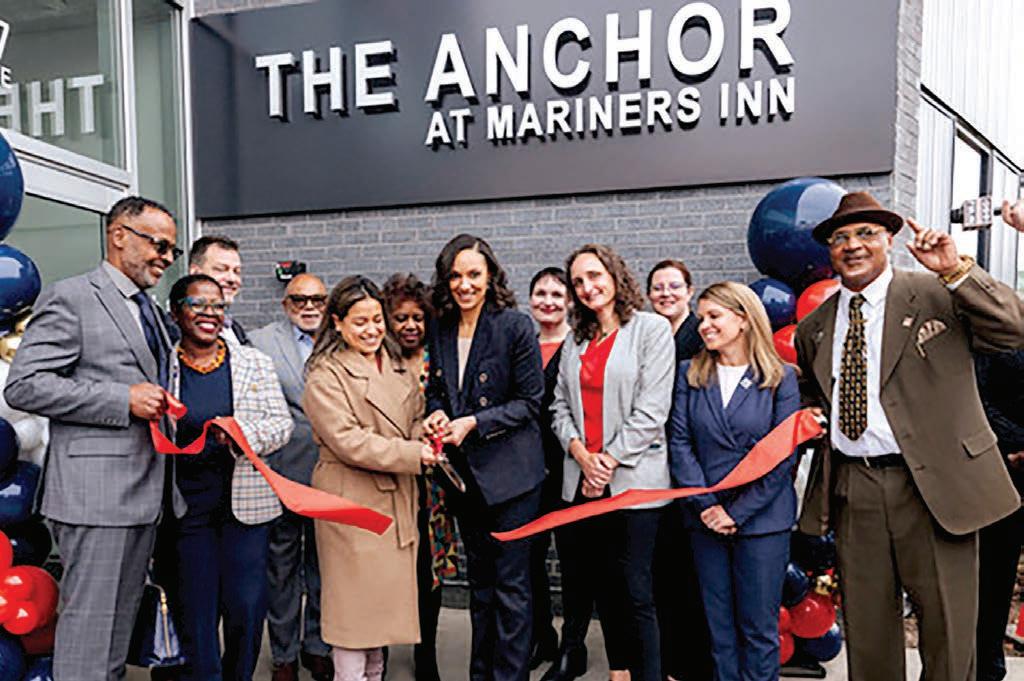
Grand Opening of $26M The Anchor at Mariners Inn Marks a Milestone in
Mayor Duggan, along with Mariners Inn and Cinnaire Solutions, proudly celebrated the grand opening of The Anchor at Mariners Inn, a 65,500-square-foot, state-of-the-art residential substance use disorder treatment facility in the heart of The District Detroit. This $25.95 million project expands critical services for Detroiters battling substance use disorder and homelessness, doubling Mariners Inn’s capacity and, for the first time in its history, welcoming women into its programs.
Located at the corner of Cass Avenue and Ledyard Street, The Anchor represents a major milestone in Mariners Inn’s nearly 100year history of providing professional, compassionate recovery services. As of March 1, 2025, all residential units are fully occupied, marking a significant step forward in addressing Detroit’s growing need for longterm supportive services.
A New Chapter for Mariners Inn and the Community
The grand opening ceremony brought together city officials, community leaders, and project partners, including Mayor Mike Duggan, who emphasized the facility’s impact on the city’s revitalization and its role in fostering lasting change.
“Mariners Inn has been a cornerstone of recovery in Detroit for decades, and with

The Anchor, they will be able to make an even greater impact on the lives of people who need the supportive services they offer,” said Mayor Duggan. “With this beautiful new facility located in the heart of our sports and entertainment district, it not only strengthens our community’s support network but also reinforces our commitment to creating a Detroit for everyone.”
The development of The Anchor follows the groundbreaking ceremony in April 2023, where plans were announced for a comprehensive residential treatment center designed to provide individuals with safe, stable housing and essential resources to support long-term recovery. The project was aided by $4.1 million from the City of Detroit from its allocation of HUD HOME funds.
“The Anchor is more than just a building—it is a
beacon of hope and opportunity,” said David Sampson, CEO of Mariners Inn. “For nearly a century, Mariners Inn has helped individuals break the cycle of addiction and homelessness. With this new facility, we can extend our services to more people than ever before, helping them rebuild their lives with dignity and purpose.”
Comprehensive Services and Support
The Anchor at Mariners Inn features 40 fully furnished apartments for individuals undergoing substance use disorder treatment and 44 permanent supportive housing units for those transitioning from homelessness. The facility provides essential services, including:
◆ Private counseling rooms and therapy spaces
◆ A new medical and mental health clinic offering holistic care
◆ Career education and job training programs
◆ Family support and prevention services
◆ A fully equipped computer lab and exercise spaces
Additionally, Mariners Inn is repurposing its existing buildings to include a new kitchen and cafeteria, an emergency shelter, and expanded service areas to better serve the needs of its residents.
“Our vision has always been to create an environment that fosters dignity and opportunity,” said Christopher Laurent, President of Cinnaire Solutions. “The Anchor’s location, within walking distance of key employment hubs, ensures that residents have access to stable housing, job opportunities, and the resources needed for long-term success.”
A Collaborative Effort for Lasting Impact
The Anchor at Mariners Inn was made possible through a partnership between the public and private sectors, reflecting the power of community-driven development. Key funding partners include the City of Detroit, Michigan State Housing Development Authority (MSHDA), the Federal Home Loan Bank of In-
Poured into Milan Park—But It Was Really Restored Community Power
By Ebony JJ Curry SENIOR REPORTER
Northwest Detroit holds the kind of stories that don’t always make national headlines but shape the soul of a community. On Evergreen Road, just around the way from Ralph W. Emerson Elementary, families have long gathered at Milan Park for after-school games, weekend picnics, and those quiet walks that give you a break from the noise. What this neighborhood didn’t have for years was investment— real, visible generational investment. That changed when Milan Park received more than $700,000 worth of improvements, a move that speaks directly to the kind of community-centered development Detroiters have been calling for.
This wasn’t a project that dropped in without notice. The City of Detroit took a different approach when deciding the future of Milan Park. In 2023, city planners didn’t just draw up blueprints behind closed doors. They engaged with the people who actually live there—families of Emerson students, neighborhood residents, teachers—folks who walk those paths daily. Their feedback helped shape a new version of Milan Park, one that honors what this community values most: space for kids to play, room for families to gather, and a park design that feels like home.
“The City of Detroit’s investment in this beautiful park highlights our commitment to Detroiters having up to date and safe spaces to play outdoors,” said Crystal Perkins, Di-
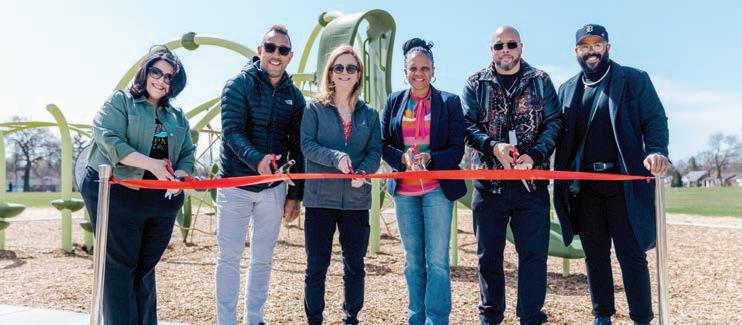
rector of the General Services Department. That investment totaled $450,000 from the city itself. The rest—$300,000—came from a coalition of partners who saw the value in backing a legacy project. Project EverGreen, the Community Foundation for Southeast Michigan, and the Gilbert Family Foundation brought dollars and direction, proving that when philanthropy aligns with the people, transformation follows.
Concrete changes now define Milan Park’s revitalization. A second playground stands as a new safe haven for children. The soccer field has been renovated, and combo soccer/football goals have been added to
expand play options. There’s a new entrance off Evergreen Road, improving accessibility for residents and families walking over from Emerson. Walkways now carve through the green space, guiding neighbors past benches, picnic tables, and BBQ grills—a clear nod to the kinds of moments this community values. Fitness equipment has been added, too, reflecting a broader commitment to wellness.
Softball has a new home here, and the game will now echo across a field that once sat neglected. This isn’t just about play; it’s about reclaiming space. Milan Park now invites people to build community, not just
pass through it.
Greenery hasn’t been overlooked, either. Project EverGreen partnered with The Davey Tree Expert Co. to tend to existing trees. That work didn’t stop with maintenance. Project EverGreen also funded and planted 35 new trees. The Greening of Detroit went further—65 additional trees now line Milan Park, Emerson Elementary, and the surrounding neighborhood. These aren’t just trees; they represent a commitment to sustainability and beauty in a city often left out of national conversations about environmental justice.
The artistic heartbeat of this renovation lives along the pavement. Detroit City Walls and Space Lab Detroit commissioned three sidewalk murals, which are due to be completed by June 2025. Miranda Kyle, part of the City Walls Blight Abatement Artist Residency Program, is bringing community-chosen murals to life—each one incorporating lemon trees. That symbol, rooted in renewal and resilience, reflects the park’s rebirth and the spirit of the people who never stopped showing up for it.
For too many kids growing up in neighborhoods where schools lack resources and gunshots are more common than opportunity, a solid park can be the only consistent, safe space they have access to. It’s where they go to escape the pressures of home, the streets, and everything that tries to rob them of their childhood. When those parks are broken down, poorly lit, or ignored, it
From page A-3
reflect an acknowledgment of real human needs and a strategy for scalable impact.
What makes these programs effective is much more than just bed count—it’s the infrastructure that supports the bed. Both SHAR and Second Chance include access to transportation for inpatient and outpatient services, behavioral health care, primary care, peer recovery coaches, and case managers who help residents map out a recovery plan that includes more than just sobriety. It includes stability. It includes a second or even third chance. It also includes the hope that someone will invest in your future when society once discarded your past.
Detroit Rescue Mission Ministries and Mariners Inn are also on deck to potentially receive funding through future contracts. Both have longstanding reputations within Detroit’s recovery and housing networks. While those contracts are still pending, their anticipated inclusion signals the city’s intent to build a more comprehensive and collaborative recovery housing system.
Detroit’s participation in the national opioid settlement has made this expansion possible. These settlement dollars are a result of legal action taken against pharmaceutical companies whose aggressive marketing and distribution practices fueled the opioid epidemic across the country. While no dollar amount can undo the generational trauma caused by addiction—especially in communities that were already under-resourced—the settlement funds offer cities like Detroit an opportunity to repair, reinvest, and reimagine recovery.
Too often, addiction is treated like an individual moral failing instead of a public health issue compounded by poverty, lack of access to mental health services, racial disparities in medical treatment, and structural disinvestment. Recovery housing, particularly in a city like Detroit, pushes back on that narrative. It creates space for healing that does not rely on punishment. It affirms that people deserve
dignity after detox.
Detroit is a city where recovery must mean more than survival. It must include belonging. SHAR’s commitment to serving both women and men reflects the city’s understanding that addiction does not discriminate by gender, but recovery often needs to. Women navigating recovery often have histories of trauma that require different kinds of support than men. They are more likely to be primary caregivers and less likely to have stable housing options after inpatient care. Adding 18 beds to the women’s unit at SHAR sends a clear message: Black women in recovery are not invisible.
Meanwhile, Second Chance is creating a pathway for men who have been written off by the system. The name itself carries weight. Second Chance isn’t just a title—it’s an intention. A man recovering from addiction in Detroit isn’t just fighting to stay clean—he’s fighting for employment, for housing, for custody, for peace. Giving him a year in a supportive environment can change the trajectory of his entire family.
Detroit’s Office of Contracting and Procurement recommended these selections after a review process that prioritized organizations with proven track records and community credibility. This isn’t about experimentation—it’s about executing strategies that center on human needs and sustainability.
Every new bed represents a real person who will no longer have to choose between recov-
ery and shelter. Every contract dollar signals a city that is no longer willing to treat addiction with one-off solutions. This investment says Detroit understands recovery requires infrastructure, not charity. It requires planning, not pity.
There’s no easy fix to addiction. That truth cuts deep across communities, especially Black communities, where addiction is often criminalized rather than treated. But when cities move from punishment to possibility, from disconnection to wraparound care, lives change. Recovery becomes less about managing symptoms and more about creating a life worth staying clean for. The expansion of recovery housing is a necessary response to a crisis that was long ignored and disproportionately shouldered by marginalized populations.
Detroit’s approach recognizes that access to treatment must be met with access to housing, transportation, therapy, and peer support. These elements, together, form the web that keeps people from falling back into the cycles they fought so hard to escape. The city’s decision to allocate settlement funds this way shows an understanding that systems of care must be holistic. Detroit is designing a blueprint for what that can look like.
Families who have watched loved one’s cycle in and out of treatment know that the work does not end when a program is completed. That’s when the real work begins. Detroit’s investment in recovery housing is a declaration: our people deserve more than temporary fixes. They deserve futures.
From page A-3
dianapolis, the National Equity Fund, Flagstar Bank, MASCO, and The McGregor Fund. Development partners include Mariners Inn, Cinnaire Solutions, and Ethos Development Partners.
“This new facility allows us to serve and support so many more people in need,” said Dave Denomme, Board Chairperson of Mariners Inn.
“It was important to us that Mariners Inn remain in its present location, ensuring
continuity and accessibility for those who rely on our services.”
About Mariners Inn
Founded in 1925, Mariners Inn is one of Southeast Michigan’s most respected substance-use treatment and recovery organizations. It provides comprehensive services, including residential treatment, job training, case management, and supportive housing, helping nearly 2,000 clients each year regain their independence, health, and self-esteem.
For more information, please visit marinersinn.org.
From page A-3
sends a message that their lives and their joy don’t matter. But when a neighborhood park is cared for— clean, functional, safe—it tells our young people the exact opposite: that they’re seen and that their lives are worth the investment.
For real Detroiters, especially parents raising children in this city, parks offer more than a place to let off steam. They’re hubs for community, mental health, and generational connections. They allow grandparents to watch their grandkids run free without fear. They give youth a place to be kids without worrying about stepping on broken glass or being harassed. Parks should be built for the block, not for show. When a neighborhood has a park that’s respected and resourced, it reflects the value of the people who live there. And in a city that’s been disrespected and divested for decades, safe, wellkept parks are a necessary right—not a reward.
“Transformations like these aren’t achieved by one person or group alone, it takes a community effort,” said Cindy Code, Executive Director of Project EverGreen. “In Detroit, we’ve seen firsthand how well-maintained parks and recreation spaces can strengthen the social fabric of a community, offering a safe and welcoming environment for people to play, exercise, and connect with neighbors outdoors.”
That message resonates. A park isn’t only green space. For Black families in cities like Detroit, it’s often one of the few places where joy isn’t policed, where connection doesn’t cost, and where culture gets passed down from generation to generation. From fathers coaching football to grandmothers grilling under the sun, parks reflect the pulse of our people.
The Gilbert Family Foundation echoed that impact. “Our contribution to the Milan Park improvements underscores our commitment to fostering vibrant, safe and inclusive spaces for Detroiters,” said Laura Grannemann, Executive Director. “Access to public space improves health outcomes and increases social connection for our communities, and we strive to support safe parks and green spaces within a ten-minute walk of every Detroit home.”
This vision falls in line with the city’s broader park investment. Since 2015, more than 200 parks across Detroit have been renovated. In 2024 alone, 44 parks received major upgrades, totaling $17 million. This isn’t a one-off victory—it’s part of a
long-overdue movement to place Detroit neighborhoods at the center of policy and funding.
What sets Milan Park apart is how that money moved with intention. It went toward elevating what already mattered to the community. Before this project, the park already had a playground, football field, picnic shelters, horseshoe courts, and a walking loop. The improvements didn’t erase the past. They built on it.
This kind of collaboration doesn’t just reshape land; it shifts narratives. For decades, Detroiters have lived with the consequences of disinvestment. Public spaces in Black neighborhoods too often face slow erosion. By bringing public funds and philanthropic dollars together, Milan Park’s transformation serves as a blueprint—proof that equity looks like visible, community-informed change.
Culturally, this upgrade signals something deeper. Northwest Detroit is filled with stories of working-class families, community organizers, school leaders, and kids with dreams as wide as Joy Road. They deserve more than symbolic progress. They deserve playgrounds that don’t rust, sidewalks that don’t crack, and murals that reflect their brilliance.
The lemon trees painted across those murals hold their own weight. They symbolize cleansing, rebirth, and even resistance. For a park named Milan, tucked beside Emerson, this artistic choice is timely. Generational trauma doesn’t heal in policy statements—it heals in spaces like this, where families can show up fully, rest, and reconnect.
No one knows a neighborhood like the people who live there. Milan Park’s revival honors that truth. City leaders may have signed off on the plans, but it’s the voices of students, parents, and lifelong residents that made this more than a renovation. It became a restoration of dignity.
This project also reflects the kind of Black-led advocacy that gets overshadowed by national conversations. When communities organize, partner, and demand equity in development, real change happens. It’s not glamorous. It’s not immediate. But it’s real. And it’s ours.
Detroit doesn’t need saving, it needs sustained investment, listening leadership, and radical respect for the people who never left. Milan Park stands as a reminder of what can happen when that happens. It’s a lesson in movement building, and it’s one every city across this country should be studying.
That $700,000 wasn’t just spent— it was returned to a community that deserved it all along.






From page A-5
Graduates of the Apple Developer Academy already set a precedent. Their presence inside a global ecosystem disrupted what tech participation looks like. That same energy now has space to move into the manufacturing sector. This isn’t about Detroit catching up. This is about others recognizing where innovation was always present — and where it continues to evolve.
Programs like this one must be paired with continued local investment. Reliable public transit, fast internet, and affordable housing remain essential. Training access means nothing when people can’t get to the classroom, stay connected or afford to live nearby. That’s not opinion. That’s reality for Detroit residents.
Talent never disappeared. What’s been missing is acknowledgment and alignment. Apple’s decision to place the Manufacturing Academy downtown sends a message. Leadership belongs here. Not in theory, but in practice.
Success will depend on how well these institutions listen to Detroiters. This work requires more than announcing programs. It requires sustained presence, shared decision-making, and honest reflection. When tech companies and universities embed themselves in community-centered strategies, everyone wins.
Young Black engineers, local entrepreneurs, and second-chance workers won’t have to imagine themselves in these roles. They’ll see it firsthand. Inside a space that was once reserved for executives, they’ll receive training designed for them — not adapted after the fact.
That’s what building futures looks like. Not with pity. With precision. Not from outside consultants. From people who understand the land they’re walking on.
Detroit stands as a force in the Midwest’s tech movement, not on the margins — but at the core. While Chicago and Columbus make headlines, Detroit builds infrastructure. Black tech leaders, innovation hubs, and grassroots developers are anchoring digital progress inside neighborhoods that have long been shut out. From smart manufacturing to mobility, fintech, and climate tech, Detroit isn’t waiting for permission. Institutions like Michigan Central, TechTown, and Black Tech Saturdays are shifting how the region approaches innovation. This isn’t just about startups. It’s about system-building that includes workforce development, digital equity, and Black ownership across every layer of the tech economy.
Leadership doesn’t always wear a hoodie or come from Silicon Valley. Sometimes, it wears Carhartt and carries a city on its back. Detroit leads by example — by investing in talent, not hype. Programs like the Apple Developer Academy, the Apple Manufacturing Academy, and STEM education pipelines across DPSCD show a deep commitment to preparing the next generation. Here, tech isn’t abstract. It’s tied to real needs: transportation, energy, education, and health. What sets Detroit apart in the Midwest tech boom is not just ambition — it’s intention. And with every investment rooted in equity, Detroit continues to shape the future of innovation with its own blueprint. Apple and MSU set a precedent by choosing Detroit. That choice brings accountability. Institutions must show that their commitment to equity is more than PR. This city already knows how to innovate. It needs collaborators who recognize that excellence, respect it, and help expand it.
Detroit stays ready. Not because it’s trending — because it always had the blueprint.
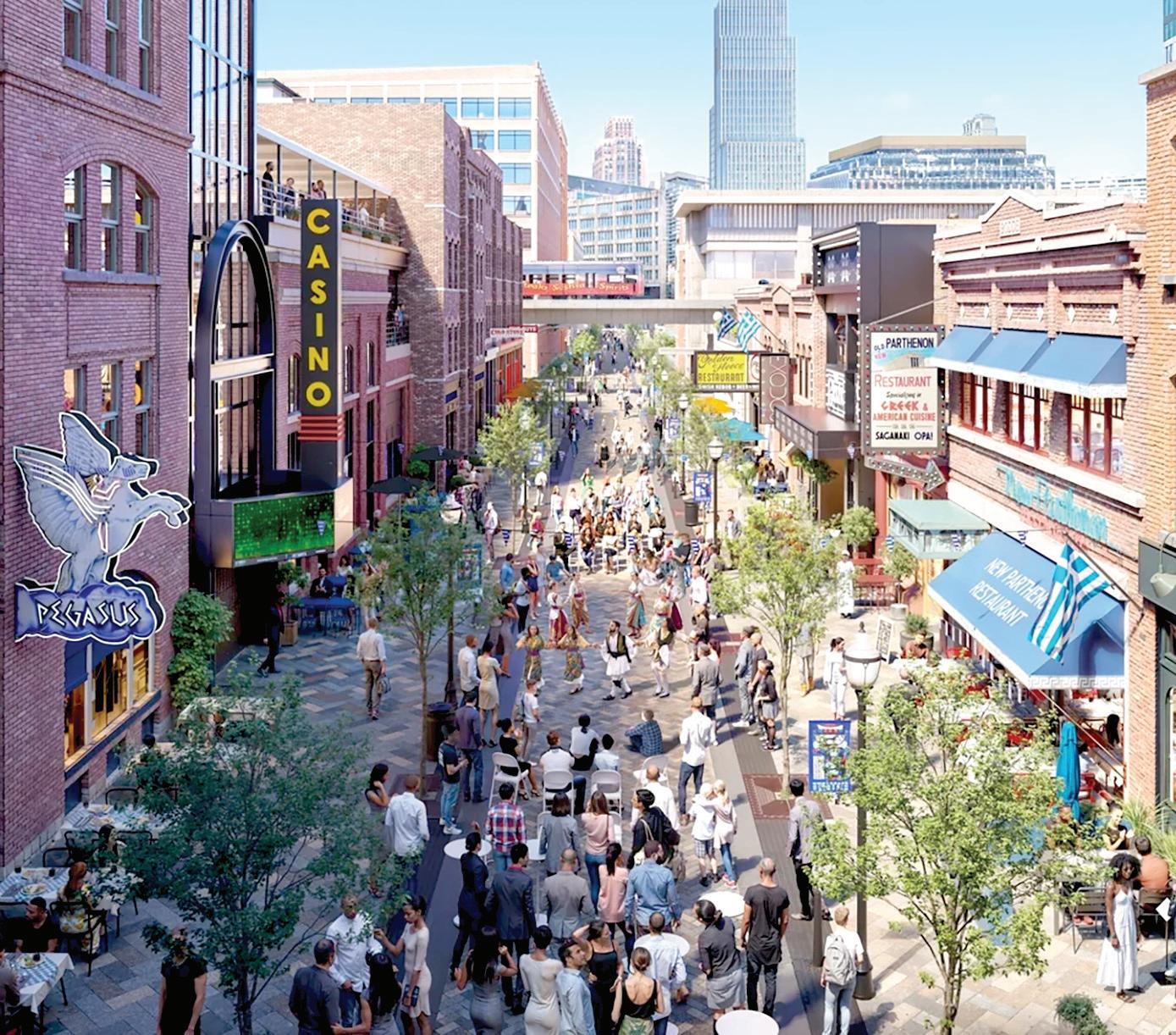
page A-5
new Greektown. In the meantime, it is important to remember that all of our businesses are open and access is as easy as it always is, with the exception of vehicular traffic holds on the road, street through construction.”
The Monroe Streetscape Project is designed to transform one of Detroit’s most beloved districts into a more walkable space. The improvements will roll out in phases, with full completion expected by summer 2026. Despite ongoing construction, businesses along Monroe Street will remain open, and pedestrian access will be maintained throughout the process.
Kelli Duff, Civil Engineer III at SmithGroup, highlighted that the project’s history goes back even further to the district-wide planning process, which called on the city and the community to emphasize Monroe Street as the heart of Greektown while uplifting pedestrian safety.
“Each day, the street attracts 1000s of locals and visitors to its eateries and entertainment venues,” Duff said.
“Monroe streetscape is such a popular pedestrian destination that is not uncommon for the streets to be closed, especially during summer, on weekends and during events. Improving pedestrian safety has been a key driver on this project.”
The Monroe Streetscape Project will introduce wider sidewalks and expanded café spaces, inviting residents and visitors to linger and enjoy the lively atmosphere. A new flexible, curb-less roadway will seamlessly transition for pedestrian-only events and festivals, turning the historic corridor into a dynamic gathering space.
“When Greektown fully reopens, it will become the first curbless through street in downtown Detroit,” Papas said.
“Greektown Neighborhood Partnership will have the flexibility to quickly and easily close the street
to accommodate large pedestrian crowds and more frequent festivals and events.”
Greektown’s transformation is more than a facelift; it’s a reimagining of the neighborhood as a vibrant, pedestrian-first destination. Traffic lanes will be reduced, and safety enhancements will be implemented to slow vehicle speeds. This will prioritize walkability and foster a more secure, welcoming environment. With these significant changes, Greektown aims to honor its history while embracing a future focused on connection, culture, and community.
“This is a transformational project for Greektown that will help it remain a premier Detroit destination for another 100 years,” Papas said.
“After extensive community engagement and overwhelming support, we’re proud to move forward with a vision that truly honors the history and Greek heritage of the neighborhood while reflecting what residents, businesses, and visitors want for the future of Monroe Street.”
Substance use disorder is a growing problem. Black overdose deaths in Michigan are more than twice that of all other residents, and are at the highest rate since 2011. This needs to change. Knowing the facts, how to reduce harm and prevent overdoses can help save lives.
Today’s drugs are more addictive and deadlier than ever before.
Whether in pill or powder form, people may not be aware of what is in today’s street drugs. Here are some facts:

Most street opioids tested contain a potentially lethal dose of fentanyl.
Xylazine, a powerful tranquilizer that is not approved for use in humans, was found in 25% of the drugs tested.
Almost 90% of ecstasy (MDMA) tablets contained more addictive compounds, like methamphetamine.
Of the Adderall tablets circulating on the street, 1 in 5 are fake and could contain more dangerous substances.
Naloxone can save lives.
Most opioid overdoses happen in the home. In 1 out of 3 overdoses, another person is present. Naloxone can rapidly reverse an overdose in minutes. The results are lifesaving.
Drug testing strips can reduce harm.
Fentanyl and xylazine drug testing strips can detect the presence of these dangerous substances in other drugs, like heroin, cocaine and counterfeit prescription pills. They can inform a person’s decision and potentially prevent an overdose. So have these drug testing strips on hand if you or a loved one are at risk.
Drug overdoses are preventable. Share the facts. Protect yourself and others. Learn how to save lives at Michigan.gov/SUD or if you need immediate support during a crisis, call 988.
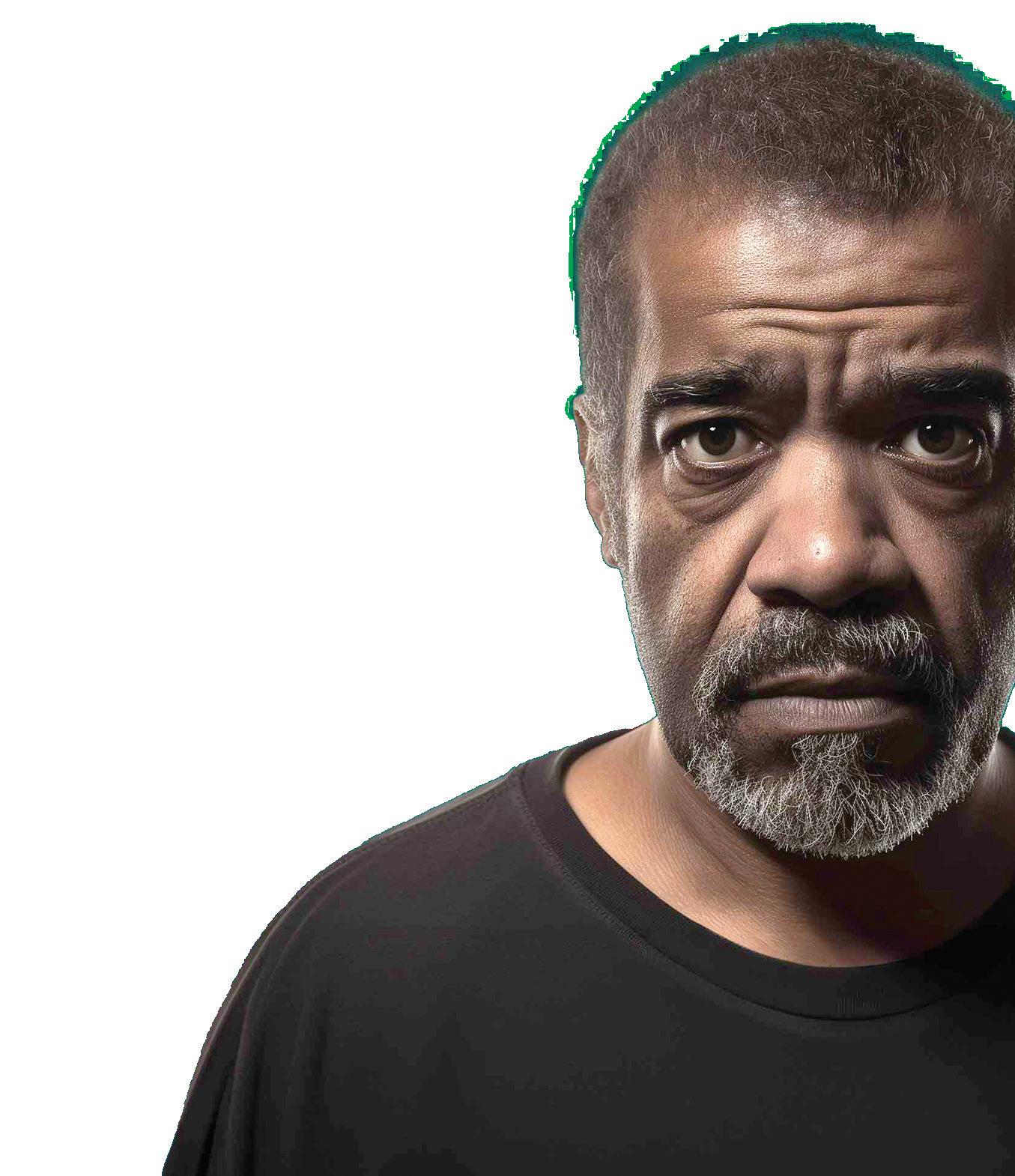

By Donald James SENIOR WRITER
Passing through Detroit’s Historic North End community, along its many major thoroughfares – Woodward Avenue, East Grand Boulevard, John R, Brush Street, Oakland Avenue, and others –offers a grand glimpse at the positive transformations that have happened or are in the process of transpiring on many fronts. From new or renovated residential, commercial, and mixed-used developments to repurposed vacant lots for urban farming or creative works of arts, the imagination and cooperation of North End residents, businesses, developers, and other stakeholders (public and private) are in constant forward thinking mode to advance the community across broad spectrums.
Even on lesser traveled residential streets in the North End, waves of progress is afoot, even if there are constant reminders that there’s more – much more - work to be done in transforming this storied community to experience better times. Nonetheless, Detroit’s North End is a vivid declaration of actionable partnerships of how strategic public and private entities should and must work in concert with others to transform underserved communities into viable areas, offering residents places and spaces to live, grow, and prosper.
Among the many organizations – public or private – that are putting its major fingerprints on the North End is The John S. and James L. Knight Foundation. Over the past few decades, the Knight Foundation has contributed millions and millions of dollars to support projects and initiatives to empower the people of the North End, an overwhelming Black populated community.
Programs funded by the Foundation have included, but are not limited to, endeavors facilitated by Vanguard CDC, an organization that has worked on behalf of the North End and adjacent Milwaukee Junction for almost 31 years. One of the major partnership projects involving Vanguard, along with the Knight Foundation’s support, was creating a pedestrian-friendly, creatively attractive streetscape stretching along East Grand Blvd., between Woodward Ave. to the I-75 service drive.
“East Grand Boulevard is a historic promenade, and the major Gateway into the North End,” said Pamela Martin Turner, Vanguard CDC president and CEO. “This project has helped us transform East Grand Blvd. into a beautiful, walkable street that can be enjoyed by the entire community.”
Other Knight-funded projects, involving cooperative partnerships with other North End-based organizations include The Next Detroit Neighborhood, a program that helped Detroit implement land-use plans for more than 4,400 properties in the North

End. The program, according to Knight sources, will help the city develop strategies to use vacant land for affordable, mix-used housing development, community gardening, and greening projects.
The Knight Foundation also supported The North End Resilience Project and the North End Resilience Project Cohort Development and Coaching, both facilitated by Michigan Community Resources. The project’s mission was to support eight grassroots organizations and community leaders in the North End, including Hip N Zen Northend, Historic North End Alliance, Inc., House 4 House, Joy Project growers, Moore Community Council, Netteworks Artistry Entertainment, Oakland Avenue Artists Coalition, and Russel Street Community Development Corporation.
“We believe that you can’t invest in a place without investing in the people who live there,” a Knight spokesperson said in a statement. “These projects are helping the North End community shape its own future, build resiliency and feel more connected to the area, and we’re proud to help support them.”
In order for any major project to succeed at any level in the North End or any other community, solid plans and strategies are critical to the outcomes. To that end, The North End Neighborhood Framework Vision, a 179-page plan, was published by the City of Detroit’s Planning and Development Department (PDD).
The North End Neighborhood Framework Vision is a comprehensive guide to support equitable and inclusive growth and stability of the North End neighborhood. It was created through a participatory planning process involving residents and community members of the neighborhood over a period of 16 months (July 2022 to December 2023).
In an exclusive interview with the Michigan Chronicle on April 2, 2025, Kevin Schronce spoke glowingly about The North End Neighborhood Framework and the level of communication and cooperation that continues to manifest itself.
“Since January 2024 to the present, we’ve done things to advance the recommendations in the North End Framework Plan, much of which has been centered on ongoing community awareness,” Kevin Schronce, Associate Director, and Central Region Design Director for the City of Detroit Department of Planning and Development (PDD), told the Michigan Chronicle in an April 2, 2025 interview. “We have provided updates on how we are going about trying to implement components of the North End Framework Plan, but also, through this process we really are working to establish relationships trying to help folks in the North End access and resource the right people at the city on various matters, some of which are not even related to the Framework. For us, it’s really about working to establishing and maintaining relationships with residents in the North End.”
PDD is not ultimately responsible for fully implementing the Framework. Instead, it is a source, a tool used by other City departments, governing bodies, agencies, and organizations for implementation and identifying where and what types of investments are needed to empower residents in the North End in multiple ways.
“The Planning Department, in this process, is like the quarterback that works to advocate on behalf of the North End through other city departments to get some of these things done,” Schronce said. “A lot of the planning processes are community driven. The community is and always will be at the forefront of our processes.”
Shirley Davis, president of the North End Neighbors Black Club, believed the North End’s greatest resources is its people, who love the community and have vowed to make it a better place now and the future.
“The North End is a great place to live,” Davis told the Michigan Chronicle recently. “There are really strong block clubs and other strong community groups dedicated to making this community better and better.”
Davis, who has lived in the North End
for more than three decades admits that it has taken dedicated work and partnering with other community residents and stakeholders in the name of cooperation and empowerment.
“Forming and maintaining strong and active block clubs, along with other community groups mean a lot to making the North End special,” Davis said. “Maintaining partnerships to reach common outcomes for the North End have always been important to me.”
Like many communities across Detroit, developing affordable housing is paramount to the community growing. In the North End, there are numerous developers who are doing outstanding work in collaborative manners to generate the development of affordable housing for adults and families.
Sonya Mays, president & CEO of Develop Detroit, is making a real difference in the North End and other communities in the city.
Her company’s portfolio of North End development projects include Marwood + Marston, a multifamily rental building located at 53 Martson St. and 12 newly-constructed apartments at 111 Marston. Develop Detroit has been a leader in building Revolution Homes, single-family “infilled homes” built in vacant parcels between existing homes. Mays’ company also developed and co-sponsored, as part of a dynamic development team, the Detroit People’s Food Co-op, a trailblazing “community-owned” grocery store located on Woodward Ave. and Euclid St. in the North End.
There are other Black Developers working to improve the affordable landscape in the North End, including Charles Dickerson III, who has built 29 brand new apartments called “The Beauton,” which is described as a mixed-use affordable housing project.
“I am truly grateful for the support that was made available by all of our partners on this project,” said Dickerson, whose company CADS III Management developed The Beauton. “Making sure these apartments were affordable is important to us. Making sure The Beauton is attainable for all Detroiters was a critical part of the mission for this project.”
“The North End is at the dawn of a new, important era,” said Jerry Ann Hebron, who operates the Oakland Avenue Urban Farm under the umbrella of North End Christian Community Development Corporate (501 c 3), whose mission is to grow healthy food, host educational programs, create cultural gathering spaces, operate a Farmers Market, and generate jobs for community residents. “As we build a place that more North End residents are involved with and proud of, and as more community needs are served, we know the North End will thrive.”
By Ebony JJ Curry SENIOR REPORTER
Flint’s students already know what it feels like to be failed by the government. They’ve learned their lessons not just from textbooks, but from poisoned water and underfunded schools. So, when the U.S. Department of Education abruptly cut off access to millions in federal dollars meant to heal the damage left by COVID-19, the pain hit familiar— deep, systemic, and intentional.
Late on the evening of Friday, March 28, without public warning, Secretary Linda McMahon sent a letter that changed everything. The letter, addressed to state education agencies like Michigan’s Department of Education, moved the deadline for federal reimbursement requests tied to pandemic relief up by a full year. Originally set for March 28, 2026, the new deadline was retroactively enforced at 5 p.m. that same evening.
That decision placed nearly $42 million in immediate jeopardy for Michigan schools. These were not theoretical dollars. These were real projects—boilers that needed replacing, air systems meant to protect students from airborne illness, and windows that keep classrooms safe and warm. This wasn’t about mismanagement or misuse. These were pre-approved contracts that school districts were actively fulfilling based on the federal government’s own timeline.
Flint City School District stands to lose the most. Of the $15.6 million it expected to receive under the American Rescue Plan, only $14.2 million has been reimbursed so far. Those remaining funds are now hanging in the balance. Statewide, 27 school districts had similar contracts. Twelve were expecting approximately $40 million in reimbursements under the American Rescue Plan. Fifteen more districts anticipated $1.9 million from the Coronavirus Response and Relief Supplemental Appropriations Act. That’s not excess. That’s essential.
This move not only threatens infrastructure projects but also jeopardizes essential programs that serve the district’s most vulnerable students.
Detroit Public School District’s Superintendent, Dr. Nikolai Vitti, has expressed deep concern over the potential impact of these federal funding cuts. He highlighted that approximately 32% of DPSCD’s budget relies on federal funds, underscoring the district’s dependence on these resources to support critical services. Dr. Vitti emphasized that cuts to programs such as Title I, which provides funding for schools with high percentages of low-income students, could have devastating effects on the district’s ability to provide quality education and support services.
The potential loss of federal funding also raises concerns about the district’s ability to maintain its free lunch program. While Michigan has taken steps to provide universal free meals through state funding, the sudden withdrawal of federal support could strain the district’s resources and impact its capacity to continue offering these essential services. Moreover, special education resources are at risk. In the 2024 fiscal year, Michigan schools received about $460 million in federal funding for special education, accounting for approximately 15% of the total funding for these services. Any reduction in this funding could hinder the district’s ability to provide necessary support to students with disabilities, potentially violating federal mandates and
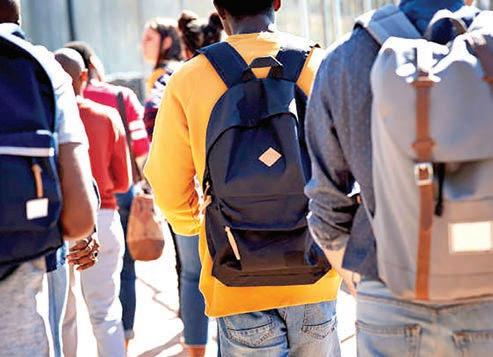
compromising educational outcomes.
The abrupt policy change has left districts like DPSCD scrambling to reassess their budgets and explore alternative funding sources. The uncertainty surrounding these cuts places additional strain on a district already working tirelessly to address the educational disparities exacerbated by the COVID-19 pandemic.
According to the Michigan Department of Education, about $24.2 million has already been paid out, but even those reimbursements may be at risk. The department confirmed that unless the federal government honors pre-approved requests, all funds—including those already disbursed—could remain unsettled.
This decision did not come after a public forum or a bipartisan negotiation. It came in a letter that claimed the previously granted extensions were “not justified.” Secretary McMahon’s words cut with precision: “Extending deadlines for COVID-related grants, which are in fact taxpayer funds, years after the COVID pandemic ended is not consistent with the Department’s priorities and thus not a worthwhile exercise of its discretion.”
That rationale ignored the on-the-ground realities of districts like Flint, Benton Harbor, and Pontiac—communities that not only suffered from COVID-19 but entered the pandemic already burdened by environmental and systemic injustice. Pamela Pugh, president of Michigan’s Board of Education, made it plain.
“As a public health professional for many years, it is a particular affront to me that the U.S. Department of Education would walk back its commitment to projects that protect the health and safety of our students—including for schools in communities such as Flint, Pontiac, and Benton Harbor that were hit especially hard by COVID-19,” she stated.
McMahon’s letter did offer one narrow path forward. Districts can request individual extensions by emailing the department, detailing why the project is necessary to mitigate COVID-19’s impact and why the extension should be granted. That vague window leaves no guarantee for approval—and puts the burden of proof on already resource-strapped districts.
State Superintendent Michael Rice addressed this shift with urgency. He emphasized that a change in federal leadership should never override standing commitments. “Without the promised March 2026 date for federal reimbursement requests, districts may be forced to reduce instructional expenditures for students, diminish savings, or
both to honor these contracts,” he wrote in a public statement.
Rice’s concern isn’t abstract. When districts planned projects using federal funds, they did so following federal guidance. Districts prioritized projects meant to directly protect students and staff—HVAC upgrades that improve air quality, window replacements that create safe environments, and ventilation systems that limit virus transmission. These were not luxuries. They were—and remain— lifelines.
This sudden reversal comes at a time when the U.S. Department of Education faces its own internal restructuring. Under the Trump administration, significant cuts are being proposed, and the shift in priorities shows. The move to claw back funds already allocated under the American Rescue Plan and the Coronavirus Response and Relief Supplemental Appropriations Act signals not just a bureaucratic redirection—it signals a disregard for Black, brown, and low-income students who still carry the weight of pandemic trauma.
Michigan’s most impacted communities are already on edge. Residents of Flint know the cost of slow federal responses and reversed promises. Families in Benton Harbor have endured years of educational neglect and crumbling infrastructure. In places where trust in government has always been fragile, this decision doesn’t just break protocol. It breaks faith.
When schools lose funding at this scale, the consequences are generational. Students may be forced to learn in buildings that lack basic ventilation. Once again, teachers may be asked to do more with less. Districts may be forced to dip into reserves meant for textbooks, tutoring, and tech upgrades. Every dollar lost means another missed opportunity to close the equity gap.
This is about more than administrative decisions. This is about the federal government’s responsibility to follow through on its commitments, especially when those commitments were made to children who have already faced some of the most challenging conditions of any generation. These students lost family members to COVID. They fell behind in learning while navigating unreliable internet and limited access to technology. They returned to schools still healing from trauma, only to now be told that the resources they were promised might not arrive after all.
Michigan’s Department of Education continues to advocate for those funds, calling attention to the legal and ethical weight of honoring commitments. However, advocacy without federal accountability is not enough.
The story doesn’t end with the secretary’s letter. The story now turns to whether or not the federal government will live up to the values it so often claims—equity, access, and a commitment to every child’s education.
Those values are tested not by speeches but by budgets. They’re proven not through policy memos but by whether or not funding reaches classrooms where the ceiling tiles leak and the air barely circulates.
Michigan’s children, especially those in Flint and other predominantly Black communities, deserve more than political reversals and retracted timelines. They deserve what was promised.
That starts with one action—honor the funding. Reinstate the original deadline. Ensure that no district is forced to sacrifice students’ well-being because of decisions made behind closed doors.





Energy is the key that unlocks the world of travel, turning every trip into an unforgettable experience. From the thrill of exploring new places to the joy of creating lasting memories with loved ones, energy is what makes it all possible.
With innovative energy solutions, we’re modernizing, protecting and maintaining our energy super systems to fuel travel and exploration today and into the future.

By Anissa Durham
THIS STORY ORIGINALLY APPEARED IN WORD IN BLACK.
Nine letters. Two words. And a history like no other.
Black hair is more than just strands of keratin. The afros, locs, braids, twists, and Bantu knots are a cultural archive, a political statement, and a source of culture and pride. Black hair is time spent in community at barber shops and hair salons, and with family in grandma’s kitchen as relatives talk while getting their braids taken down.
But for centuries, Black hair has also been a target — discriminated against in classrooms, policed as unprofessional in the office, condemned in the military and sometimes even in the mirror. The message to Black people, and women in particular, has always been clear.
Your hair is a problem.
The stories are everywhere: Texas high school student Darryl George suspended for his locs Fort Worth resident Kerion Washington denied a summer job at Six Flags due to his dreadlocks. Louisiana woman Imani Jackson fired from her job for wearing her natural hair.
“Our hair is often misunderstood and stressed, forced to do things that go against its nature, like withstanding extreme heat, harsh chemicals, rubbing stocking caps and glue, toxic laden synthetic hair, and wigs to conform with Eurocentric beauty standards and fashion trends,” says Dr. Afiya Mbilishaka, a clinical psychologist and hairstylist who researches the intersection of Black hair and mental health.

But trying to conform to Western beauty standards — soft, straightened, perhaps lightly kissed by the curling iron — can be hazardous to your health.
Last month, an Environmental Working Group analysis found that, out of some 4,000 hair and beauty products marketed to Black women, 80% of them “contain at least one moderately hazardous ingredient — and most contain multiple.” That includes hair-care products with chemicals that elevate the risk of cancer.
That’s why Dr. Raven Baxter, a scientist and social media influencer known as Raven the Science Maven, officially declared a truce with her hair — by cutting all of it off.
“I have fully divested from the long hair industrial complex,” she said in a recent Instagram post. Black women, she said, are at war with their hair, “and it’s a war we didn’t even start. And I am no longer gonna fight in that war. It’s causing me unnecessary stress.”
The CROWN of Black Hair
In recent years, there have been signs that society is taking the conflict seriously. In 2019, California became the first state to pass the CROWN — Creating a Respectful and Open World for Natural Hair Act. Former California State Senator Holly J. Mitchell, a Democrat and a Black woman, authored the bill in part after reports of Black women being fired or disciplined in the workplace because of their hairstyle.
As of April 2025, 27 states have passed the CROWN Act into law.
Tuskegee University student Haileigh Trainer, 21, says the law shouldn’t be necessary, but had to happen “because of the discrimination we face. I think Black hair is policed not just in school but in the workplace.”
The data tells the story: According to the CROWN 2023 Workplace Research Study, about 20% of Black women aged 25 to 34 reported being sent home from work because of their hair. Black hair is 2.5 times more likely to be perceived as unprofessional, and more than half of Black women say they believe they have to wear their hair straight for a successful job interview.
Angel Mayfield, 20, a Florida A&M University student, says she is one of them, although she has contemplated whether to wear a natural style. What stops her, she says, are the stereotypes often associated with natural Black hair.
“We always have to think of ways to make ourselves look acceptable or professional,” she says. “I don’t think that’s right.”
For most of her life, Mayfield says, her hair was chemically straightened; she can’t remember the first time her parents put a relaxer in her hair. When she got old enough to make her own choices, Mayfield was the first in her family to stop straightening her hair. It was more than just prioritizing her hair health. It was, she says, about reclaiming her power. Centuries of Discrimination
Before the newly enslaved were shipped to America, the first act of the enslaver often was to cut off their hair — an act of dominance, control, and dehumanization.
“The shaved head was the first step the Europeans took to erase the slave’s culture and alter the relationship between the African and his or her hair,” authors Ayana D. Byrd and Lori L. Tharps wrote in the book “Hair Story,” which documents the Black hair experience in America. Without their distinctive tribal hairstyles, they wrote, “Mandingos, Fulanis, Ibos, and Ashantis entered the New World, just as the Europeans intended, like anonymous chattel.”
White enslavers ridiculed Black features, forced Black women to adopt white beauty standards, and created a social hierarchy, elevating those with lighter skin and straighter hair. Natural Black hair — from tightly coiled, cottony, and coarse to loosely curled and finely textured — was condemned as dirty, rough, and unkempt.
“Well may we scoff at black skins and woolly heads, since every model set before us for admiration, has a pallid face and flaxen head,” writer William J. Wilson wrote in 1853 in “Frederick Douglass’ Paper.” By the 1770s, the term “good hair” emerged to become an enduring part of the Black beauty lexicon: the closer Black hair came to white hair texture, the better it was assumed to be.
That standard made millionaires of Madam C.J. Walker, a Richmond beautician. In the 1920s, Walker patented methods of straightening out Black kinks and coils. Over time, chemical relaxers became another tool to give Black folks that sleek Eurocentric look, a standard that dominated Black beauty culture for generations.
During the Black Power movement of the 1960s and ‘70s, Black Americans embraced their textured hair by wearing an Afro as a sign of resistance and pride. Later in the 1990s, box braids became popular; in the early 2000s, with the rise of blogs and YouTube, the natural hair movement took off.
Going Natural
Trainer, the Tuskegee University student, says she has a love-hate relationship with her hair. Growing up, she got her hair pressed for special occasions and holidays, a ritual she didn’t enjoy.
“The hot comb was on the stove, the grease was out, and the towel was there. It was dreadful,” she says. “I felt like I had to always straighten my hair. It could never be in its natural state.”
Trainer says her confidence in her natural hair developed in high school, after she transferred from a predominantly white school to a school with more Black students. The experience was liberating: her hair went from being a curiosity to a nonissue.
“Now I feel very empowered by my hair,” she says. “I think my hair just adds a little razzle-dazzle to who I am.”
Mayfield, the Florida A&M student, calls her experience a selflove journey: “I’m reclaiming my own identity and reclaiming what’s mine.” Sometimes, she says, it isn’t easy. Still, “I love myself more for being able to stand up for myself, stand up for my hair, and stand up for what I believe in.”
“Dealing with our type of hair takes hours. It takes a village,” Mayfield says. “But I think being a Black woman that embraces her Black hair, it makes me capable to combat anything in the world. If I’m able to deal with my curls and kinks, I’m able to do everything else.”

labor have historically generated immense wealth, yet time and time again, that wealth has been stripped away or denied to the very people who created it.
“From places like Black Wall Street to countless other communities, there has been a deliberate effort to remove economic power from Black hands,” Dandridge said.
The Ride for Equity is a tribute to the legacy of Black Wall Street and a call to action for economic justice. Cyclists will set out on May 31, 2025, at 7:00 AM from 400 N. Main St. in Tulsa, Oklahoma, a location that once thrived as a symbol of Black prosperity. From there, riders will navigate through multiple states, pushing through diverse landscapes while raising awareness and funds to combat the racial capital gap. The ride will culminate in New York City on July 4, 2025, where the journey’s triumph will coincide with a nationwide celebration of independence, yet another opportunity to highlight the economic inequities that still persist.
Along the way, riders will connect with local communities to amplify their message of economic justice. Every mile ridden is a step closer to highlighting the critical
• Week 1: Tulsa, OK ➔ Rolla, MO (330 miles)
• Week 2: Rolla, MO ➔ Terre Haute, IN (325 miles)
• Week 3: Terre Haute, IN ➔ Belmont, OH (400 miles)
• Week 4: Belmont, OH ➔ State College, PA (270 miles)
• Week 5: State College, PA ➔ Wall Street, NY, NY (320 miles)
need for equitable access to capital and opportunities for entrepreneurs of African descent.
“Ride For Equity was life-changing. The sense of community and purpose keeps me motivated to continue the fight for economic justice,” A. Johnson, a past participant, said.
This is a chance to be part of something larger than oneself. Cyclists from around the world are invited to join this historic journey, whether by riding the full route, participating in a portion of the ride, or cycling independently in their own cities. Every participant will contribute to making a tangible difference in the fight for economic justice.
Participation in the Ride for Equity is open to cyclists from around the world! Whether you choose to ride the full 1,645-mile route, join a portion of the journey, or cycle independently in your own city, you can be part of this transformative movement.
“Participating in this ride opened my eyes to the challenges entrepreneurs of African descent face and the importance of solidarity within our communities,” J. Smith, a past rider, said.
Cyclists who raise or donate at least $100 by July 4, 2025, will receive the official Ride For Equity jersey. If the fundraising goal isn’t met, participants agree to cover
The programs are designed to cultivate essential life skills, including teamwork, resilience, and leadership. They strongly emphasize supporting students from low-income communities, ensuring that these innovative learning opportunities are accessible to those who stand to benefit the most. They strive to inspire the next generation of thinkers and innovators through initiatives, equipping them with the knowledge and skills necessary for success in an ever-evolving world.
“The scholars meet on Thursday for one hour after school, Benning said.
“And I’ve also been able to be creative with it and utilize some recess time for the students to get together and practice and play, as well as time during dismissal, where they can just sit down and get a practice game going while they’re waiting to be dismissed.”
GameChanger, which is part of DICK’s Sporting Goods, believes
that playing sports can have a positive impact on young people’s lives, both in sports and beyond.
One of their key programs is NBA Math Hoops Live, which connects sports with learning, especially in math and science.
GameChanger uses its expertise in technology to create fun and valuable experiences for students all over the country. By combining education and athletics, NBA Math Hoops Live inspires students to grow academically and personally while enjoying the game they love.
Benning highlighted that when other students hear about Math Hoops, they ask, ‘Oh, can I join Math Hoops? Can I play?’ They want to be involved in Math Hoops and say, ‘This is fun math.’
“They’re really excited. There’s an upcoming regional tournament happening next Wednesday,” Benning said.
“Right before spring break, students were excited and asked when they would find out if they
the remaining balance. You can choose your own route, ride at your own pace, and share your journey on social media because every mile counts in the fight for economic justice.
Join Black Leaders Detroit and the Community Light Foundation for the ceremonial kickoff and start of the ride on May 31, 2025, at 7:00 AM from 700 North Greenwood, Tulsa. Riders will have the option to participate in a 15-mile or 35-mile route, honoring the historic site of Black Wall Street and beginning their journey of hope and change.
Whether participants ride in Tulsa, New York City, or from their own hometowns, their involvement contributes to creating a future where African American entrepreneurs have the access and resources they deserve. By uniting for this cause, riders can help close the racial capital gap and pave the way for a fairer, more just economy.
“Through the Ride for Equity, we are shining a light on these injustices, not just as history, but as an ongoing reality,” Dandridge said.
“Our goal is to inspire action and remind people why it’s critical to fight for equity in opportunity and resources today.”
Registration is now open at www.blackleadersdetroit.org.
would get selected to play in the tournament. They’re going to be ecstatic to find out that all of them have been selected to participate in their first regional tournament.”
NBA Math Hoops Live is a free program allowing students to actively engage with learning through fun, hands-on activities. Some selected sites will receive kits and materials for engaging, on-court games. Teachers will also get support and resources from the Learn Fresh team to help make the program more effective and enjoyable. The flexible program can be used in various settings, including school and after-school programs, so teachers can adjust it to fit their students’ needs.
Rebecca Wasserman, GameChanger VP of Strategic Initiatives and Impact, emphasized at GameChanger that they understand the lessons learned through sports extend well beyond the court.
“By partnering with Learn Fresh to support NBA Math Hoops, we’re proud to give students a hands-on way to strengthen their math skills while staying active and having fun,” Wasserman said.
from various mediums, it offers a glimpse into the creativity fostered within the city’s schools.
Lecture Series
On April 17, from 5:30 p.m. to 6:30 p.m., the DIA will host “Urban Renewal and Social Inequality: Paris and Detroit,” a lecture examining the parallels between the two cities. Additionally, on April 28, from 10:30 a.m. to 12 p.m., the “2025 Friends of Art & Flowers Elizabeth Sites Kuhlman Lecture” will delve into the intersection of art and horticulture.
Guest Artist Workshop: Polymer Clay Essentials with Trice Clark
On April 19 and 20, from 12 to 4 p.m., the Detroit Institute of Arts will host a Guest Artist Workshop: Polymer Clay Essentials with Trice Clark. This handson workshop invites participants to explore the fundamentals of working with polymer clay, guided by expert artist Trice Clark. Attendees will learn essential techniques for sculpting, shaping, and designing unique clay creations, making it a perfect opportunity for both beginners and experienced artists to expand their creative skills.
The Charles H. Wright Museum of African American History
Situated at 315 Warren Avenue (across the street from the DIA), the Wright Museum offers a series of events and exhibitions that celebrate African American culture and history. This year is the museum’s 60th Anniversary, and what better way to commemorate it than with an in-house exhibition celebrating the life and achievements of its founder, Dr. Charles Howard Wright? Attendees can delve into the history and impact of Dr. Wright’s vision for African American cultural preservation.
Upcoming Exhibits
Luminosity: A Detroit Arts Gathering
Opening on April 5, 2025, Luminosity: A Detroit Arts Gathering is a landmark exhibition at The Charles H. Wright Museum of African American History, celebrating 60 years of cultural excellence. Showcasing 60 artworks from both legendary masters and contemporary Detroit artists, this collection captures the brilliance and resilience of African American artistry. Visitors can immerse themselves
in pieces that span generations, including See No Evil (2021) by acclaimed artist Johnathan Harris, a striking work that challenges perception and provokes thought. Luminosity promises to be a radiant tribute to the past, present, and future of Detroit’s artistic legacy.
Second Sundays at The Wright
In partnership with Bank of America, the museum provides free admission on the second Sunday of each month. On April 14, visitors can explore all exhibits and participate in special programming without any cost. This initiative aims to make cultural experiences accessible to all.
The Wright Conversations
On April 9 at 5 p.m., the museum will host a discussion featuring Kwame Alexander, an internationally renowned poet and New York Times bestselling author. This event is part of a series that brings thought leaders to engage with the community on topics spanning literature, law, music, and dance.
Grow Your Garden: Planting Seeds and Connections
On Saturday, April 26th, from 2 p.m. to 5 p.m., The Wright Museum invites visitors to “Grow Your Garden: Planting Seeds and Connections” in the Community Room. This interactive event encourages participants to embrace the spirit of spring by learning hands-on gardening techniques while fostering meaningful connections with fellow community members. Whether you’re a seasoned gardener or just getting started, this workshop offers a space to cultivate both plants and relationships in a nurturing and educational environment.
2025 NEA Jazz Masters Tribute Concert
On Saturday, April 26th, at 8 p.m. EST, jazz enthusiasts can experience the 2025 NEA Jazz Masters Tribute Concert, a free event honoring the latest recipients of the prestigious NEA Jazz Masters Fellowship. This year’s honorees include saxophonist Marshall Allen, pianist Marilyn Crispell, and Cuban jazz legend Chucho Valdés, along with the 2025 inductee. Held both in person and online, the concert promises an unforgettable night of world-class performances celebrating the enduring legacy of jazz.
For more information, visit https://dia.org/ and https://www.thewright.org/

By Amber Ogden
STAFF WRITER
A new era of celebrations has arrived in downtown Detroit. Bedrock has unveiled The Department at Hudson’s, a dazzling, high-tech collection of event spaces that blend the city’s storied past with modern sophistication. Spanning an impressive 56,000 square feet and designed to host everything from grand weddings to corporate conferences and star-studded premieres, The Department is set to become Detroit’s go-to destination for unforgettable experiences. With breathtaking skyline views, cutting-edge audiovisual capabilities, and a world-class hospitality team led by Marriott International and Forte Belanger, this venue is more than just a space. It’s the future of events in the Motor City.
Located inside the monumental Hudson’s Detroit development in the heart of Downtown on Woodward Ave., this collection of 15 distinct, fully customizable venues was designed to blend the city’s rich history with cutting-edge innovation. Imagine wrap-around terraces with heated flooring and twinkling city lights as your backdrop, a concert-worthy sound system, and retractable seating that transforms to fit any vision. This isn’t just an upgrade; it’s a game-changer.
Bedrock, the visionary development company reshaping downtown Detroit, partnered with hospitality giants Marriott International and renowned caterer Forte Belanger to create a venue unlike anything the city has seen before. Marriott will market and sell the event spaces, while Forte Belanger will handle the food and beverage service, ensuring a seamless and luxurious experience for every guest.
Ivy Greaner, Chief Operating Officer at Bedrock emphaszied Detroit is known as a top destination for events, conferences and gatherings, and The Department at Hudson’s is the perfect setting to welcome guests from near and far.
“With downtown as its backdrop, Bedrock has created a collection of flexible spaces to experience event excellence,” Greaner said.
Whether planning a grand gala or an intimate gathering, The Department at Hudson’s offers a variety of spaces to suit every occasion. The second floor, boasting 33,000 square feet of event space, is tailor-made for large-scale conferences, trade shows, and upscale social events. With floor-toceiling windows, sleek pre-function areas, and high-tech soundproofing, every event here is set up for success. Need more space? The third floor’s nine breakout rooms and expansive area provide the perfect setting for workshops, meetings, and networking events.
Beyond its luxurious aesthetic, The Department at Hudson’s was built with convenience in mind. From on-site catering kitch-
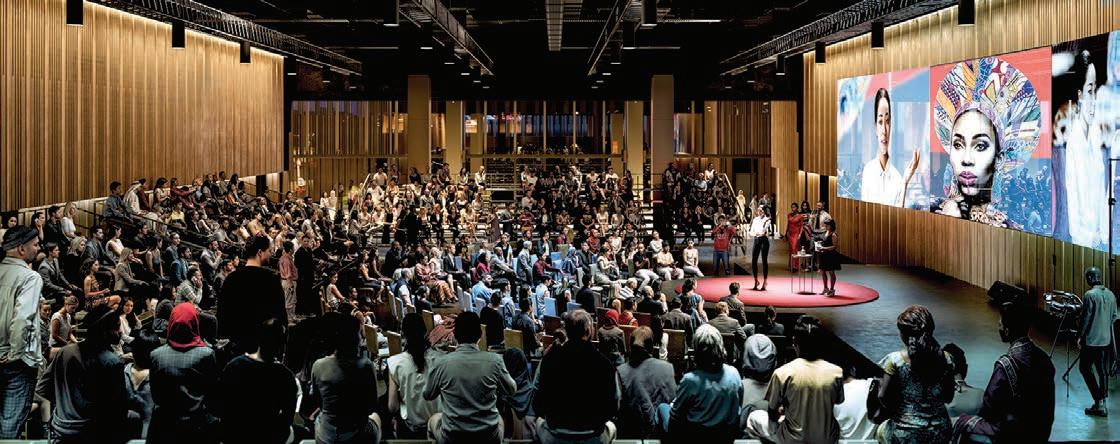
ens to intuitive touch-screen wayfinding, every detail is designed to create a seamless experience for both hosts and guests. A cutting-edge Audio/Visual system designed by Theatre Projects, the nation’s premier indoor production company, ensures that performances, conferences, and celebrations come alive with crystal-clear sound and immersive visuals. Plus, retractable Jezet seating can be arranged to match the mood and format of any event.
It’s not just businesses and conference-goers who will be flocking to The Department at Hudson’s; Detroit’s social scene is about to level up. Weddings, milestone celebrations, and high-profile fashion shows are set to make this venue the city’s most sought-after address. Picture saying “I do” on a terrace overlooking the skyline or hosting a gala under dazzling, customizable lighting. The possibilities are endless.
Julius Robinson, Chief Operations Officer – U.S. West, Marriott International, highlighted being excited to collaborate with Bedrock on this groundbreaking development, helping to bring unparalleled experiences to life for The Department’s guests.

“Our sales and marketing teams, along with Forte Belanger, are poised to provide exceptional, high-touch service, leveraging our global reach, deep expertise in the luxury and lifestyle space and commitment to outstanding customer service,” Robinson said.
The Department at Hudson’s is the latest in a series of Hudson’s Detroit announcements as the project nears completion.
Transforming the Detroit skyline, the 1.5 million-square-foot development is comprised of ground-floor retail, modern office space including the new General Motors Company global headquarters, a 5-star Detroit EDITION hotel, a public plaza, rooftop lounge, and The Residences at The Detroit EDITION high-rise condominiums.
To inquire about The Department at Hudson’s and additional information, please visit Hudsons-Detroit.com




By Ebony JJ Curry
Senior Reporter
Cory Booker stood in the U.S. Senate for 25 hours without sitting, eating, or leaving the floor. That choice didn’t come from ego or ambition. It came from a responsibility to people whose voices don’t echo through Capitol Hill. The single mother is trying to hold on to Medicaid. The veteran whose mental health depends on Medicare. The elder in Detroit who built this country now can’t get through to Social Security. Booker didn’t come to perform. He came to bear witness.
“For almost 20 hours, we have laid out what they’re trying to do. Twenty hours. I want to stand more, and I will, but I’m begging people: Don’t let this be another normal day in America,” Booker said. He brought with him 1,164 pages of real stories. Names. Lives. People who will lose care, access, and stability under Donald Trump’s second-term agenda. These weren’t hypotheticals. They were warnings. Booker made sure every letter was read in the Congressional record.
One came from a woman whose life depended on Medicaid. “Medicaid has saved my life many, many times. Without it, many people in America will die. Please help us.”
Another came from a Navy veteran.
“Dear Senator Booker, when I got out of the Navy, I had mental illness. I needed psychiatric medicine to stop going in and out of the hospital. Because of Medicare I have medicine that has kept me out of the hospital for 18 years.”
These weren’t pulled for effect. They reflected what millions already know—this government is balancing its future on the backs of the vulnerable.
Republicans in Congress are pushing for hundreds of billions in Medicaid cuts. Over 70 million Americans rely on it—many of them children, seniors, and women of color. Medicaid isn’t a cushion. It’s a foundation. When it’s removed, people don’t struggle. They fall.
Trump claims cuts would only target waste. But the Congressional Budget Office has shown otherwise. The budget math doesn’t allow for vague intentions. The numbers make clear that massive reductions to Medicaid, Medicare, and the Children’s Health Insurance Program are necessary to fund the tax breaks already proposed. Those breaks benefit the wealthiest. The burden falls on everyone else.
Booker kept reading. His voice stayed steady. His body stayed upright. He moved to the gutting of Social Security—not as a headline, but as a lived crisis.
The Department of Government Efficiency, known as DOGE and led by Elon Musk, has already cut thousands of Social Security
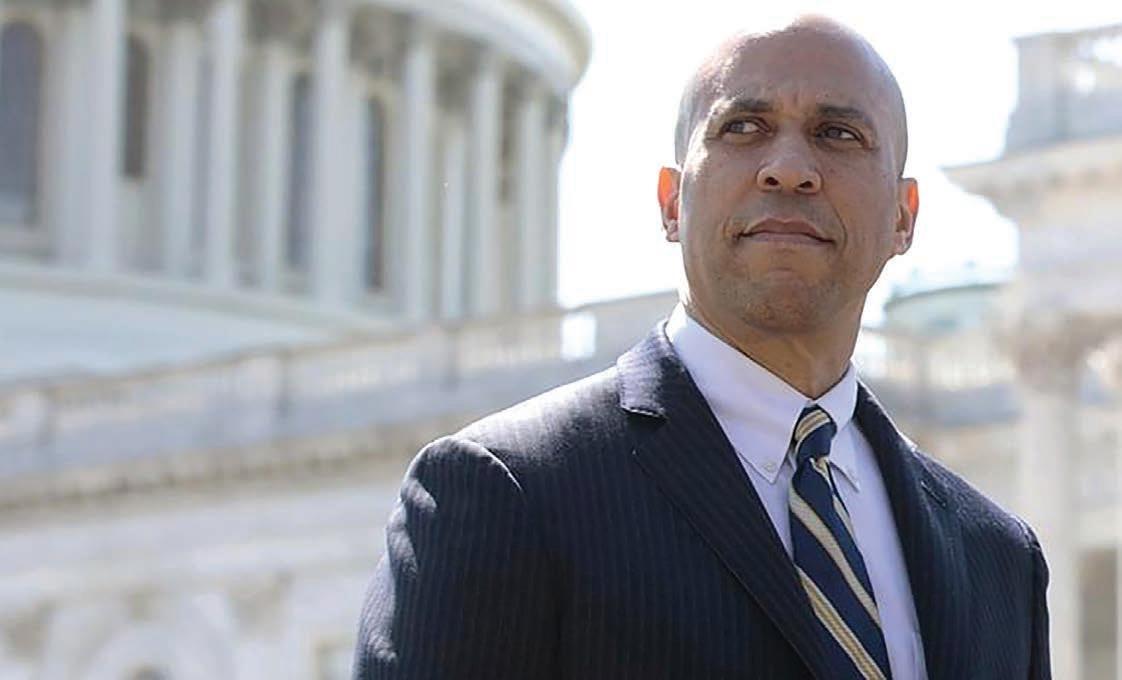
staff. The agency’s website failed four times last month. Seniors and people with disabilities couldn’t access their accounts. Booker named the breach of trust.
“Ninety years. Our country has made a promise to people that if you pay into the Social Security program your whole life, that money will be there for you when you retire.”
That promise has been broken. Four out of every ten seniors in America rely on Social Security as their only income. They don’t have second streams. They don’t have savings buffers. They have a monthly check and the hope it will arrive on time.
“There are so many hard-working families that believe in this idea, if I work hard all my life in America, I can make ends meet, I can raise my kids, and I can retire with dignity,” Booker said. “Social Security is not the government’s money to spend. It’s the hard-earned savings of working Americans… The president and Elon Musk need to keep their hands off of it.”
He stood for five more hours and turned his focus to education. The Department of Education is targeted for elimination. The plan? Strip its authority by executive order and spread its responsibilities across underfunded federal agencies.
“By executive fiat, undermining the separation of powers, the administration wants to dismantle, defund, destroy the Department of Education and scatter its responsibilities across agencies that them-

selves are going through massive personnel cuts and are not equipped to handle them,” Booker said.
That move won’t impact elite schools. It won’t disrupt private education. It will collapse supports for low-income students, students with disabilities, and working-class families who depend on federal protections.
Booker didn’t speak to preserve a department. He spoke to protect a right. The right for every child—regardless of zip code—to receive an education with dignity and support. He named what many know: when education gets dismantled, Black and brown students lose the most.
As the hours pressed on, so did Booker. He never shifted his tone. He stayed with the letters. He stayed with the people. Then came the reflection on the moment itself.
The last man to hold the record for the longest Senate speech was Strom Thurmond. His 24-hour stand in 1957 tried to block the first civil rights bill since Reconstruction. That history never left the room.
“I’m getting close to a record, folks,” Booker said. “There’s a room here in the Senate named after Strom Thurmond. To hate him is wrong. Maybe my ego got too caught up that if I stood here, maybe, maybe, just maybe, I could break this record of the man who tried to stop the rights upon which I stand. I’m not here, though, because of his speech—I’m here despite his speech.”
That truth hung heavy. The record Booker broke had been held by a segrega-
tionist. Booker claimed it with purpose. Not to erase the past—but to confront it. He remembered Congressman John Lewis before closing. Lewis walked into danger without flinching. He gave more than speeches. He gave his body.
“I beg folks to take his example of his early days, where he made himself determined to show his love for his country, at a time the country didn’t love him,” Booker said. “He said he had to do something.” Booker ended with Lewis’s call: “This is a moral moment. It’s not left or right, it’s right or wrong. Let’s get in good trouble.” This wasn’t a record-breaking speech. It was a record-setting one. Booker stood because millions of Americans are being pushed down while corporations are lifted up. He stood because silence would have confirmed consent. He stood because sitting would have meant surrendering. From Newark to Detroit, these policies are not abstract. They are felt in missing paychecks. Missed appointments. Missed chances. The community already knows what it means to stretch. What it means to survive. But survival should not be the ceiling.
Booker made the floor his stage, but not for the spotlight. For the stories that never get heard, the names that never get said, and the futures that still depend on someone choosing to stand. He didn’t sit. Because too many of us still can’t afford to.


